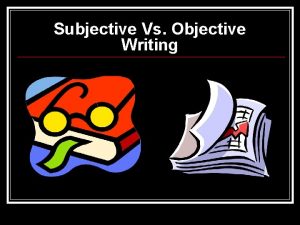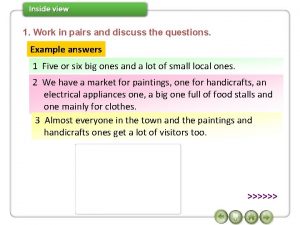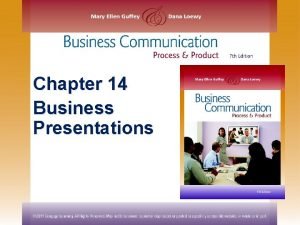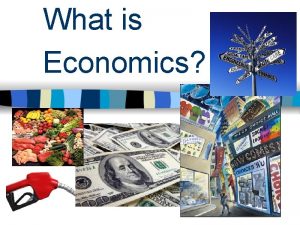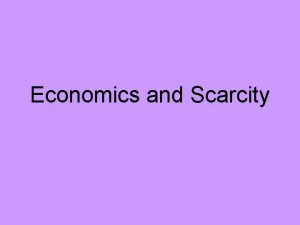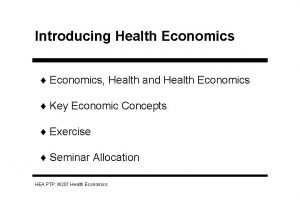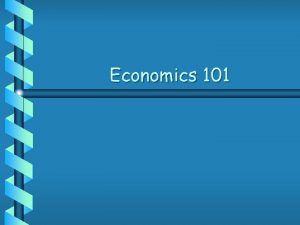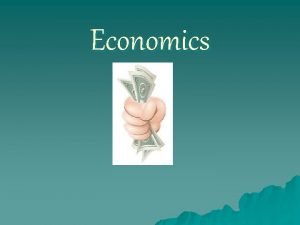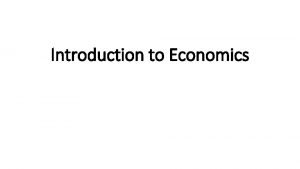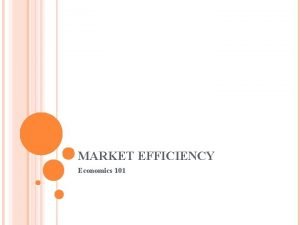Week 8 Economics I Topics of Week 8
























































- Slides: 56

Week #8 Economics I

Topics of Week #8 1. 2. 3. 4. 5. 6. 7. 8. 9. Long-Run Costs Defining Monopoly Characteristics of Monopolies Profit Maximizing Rule for Monopoly* Contrasting Competition and Monopoly* Problems with Monopoly* Deadweight loss (DWL) of Monopoly* Solutions to Monopoly* Government Failure "*" Indicates the most important topics. Mateer and Coppock: Chapter #8 and #10

Long-Run Costs • Scale – Size of the production process • Efficient scale – The level of output in which ATC is minimized – Note that the MC curve passes through the minimum of the ATC curve.

Long-Run Costs • Economies of scale – ATC falls when production expands. – Larger firm is more efficient than a smaller firm. • Diseconomies of scale – ATC rises when production expands. – Very large firm has to deal with additional management, coordination, logistics expenses. • Constant returns to scale – ATC doesn't change when production expands. – Olive Garden builds another restaurant. Requires same K and L as previous restaurants. Output is similar.

Costs in the Long-Run

SR and LR Cost Comparison • The short-run cost curve and the long-run cost curve are both U-shaped. However, they are U-shaped for different reasons! • SRATC – U-shaped because of diminishing marginal product – MPL falls, MC rises, and ATC follows MC. • LRATC – U-shaped because of economies and diseconomies of scale – Smaller firms can lower costs by growing, but if they get too big, costs can grow.

Previously • Profits and losses act as signals in a perfectly competitive market. • For perfect competition to exist, two factors must be in place: – A perfectly competitive market – Easy entry and exit from the market • A price taker has no control over the price it pays, or receives, in the market. • A firm that maximizes profits will expand output (Q) until MR = MC = P

Defining Monopoly • Monopoly – Single seller who sells a product without close substitutes – It can prevent entry for new firms. – Ability to set the price of a good or service • How do monopolies persist? – Recall what happens in perfectly competitive markets with free entry. • Barriers to entry – Restrictions that make it difficult for new firms to enter a market – Allows many monopolists to enjoy long run economic profit.

Is Google a Monopoly? Is Microsoft a Monopoly?

Is AT&T a Monopoly? Is US Steel a Monopoly?

Is Standard Oil a Monopoly?

Economics in Forrest Gump • "Forrest Gump" – Forrest Gump goes into the shrimping business.

Natural Barriers to Entry • Natural Barriers to Entry – Control of resources – If a monopoly controls all of a resource (input) necessary for production, competitors cannot enter – ALCOA, De Beers • Inability of potential competitors to raise enough capital – Monopolies are often very established after years of growing. Can you raise $10 million of capital to compete?

Natural Barriers to Entry • Economies of scale – "Bigger is better" (more cost-efficient) – This is due to the ATC being downward-sloping over a large range of output. – Lower costs lower prices – Car production, electricity production, mail delivery • Natural monopoly – A monopoly exists because a single large firm has lower costs than any potential competitor. – In addition, breaking up the firm into multiple competitors may increase costs as well.

Government Created Barriers • Licenses, qualifications – License to use certain radio or TV frequency (prevent the negative externality of interference) – Must be qualified to practice medicine or law • Patents and copyright law – Patent • Temporarily grants monopoly rights to a product • An incentive to innovate – However, copyrights (and higher resulting prices) sometimes create unintended consequences. • File sharing, movie pirating

SNAPSHOT The Demise of a Monopoly 1, 100 PC 1, 000 Since 2007, the explosive growth of smartphone and tablet sales has tilted the operating system market toward Android (owned by Google) and Apple, eating into Microsoft's market share. i. Mac Unit Sales (millions) 900 i. Phone Android Devices 800 i. Pad 700 600 In the early 2000 s, Microsoft controlled nearly 100% of the operating system market (through PC sales), but Apple sold enough of its Mac computers to remain in business. 500 400 300 200 100 2001 2002 2003 2004 2005 2006 2007 2008 2009 2010 2011 2012

The Monopolist's Pricing and Output Decisions • Perfectly competitive firms – Price takers cannot affect the price. – Each firm faces a horizontal demand. • Monopoly firm – Price maker sets the price by choosing output level. – Faces the downward-sloping demand curve for the entire industry


Comparing Demand Curves

Profit Maximizing Rule for Monopoly • Similarity between monopoly and perfectly competitive firms – Profit is maximized at output level (Q) where MR = MC • Difference between monopoly and perfectly competitive firms – In perfectly competition, P = MR = MC – In monopoly, P > MR = MC – To increase output, monopoly must lower the price. Perfectly competitive firms can sell as much as they want at the market price.

Monopoly Marginal Revenue per 1, 000 Quantity (MR) = ΔTR Quantity (Q) Price (P) Total Revenue (TR) = Q P 0 $100 $0. 00 1, 000 90 90, 000 $90, 000 2, 000 80 160, 000 70, 000 3, 000 70 210, 000 50, 000 4, 000 60 240, 000 30, 000 50 250, 000 10, 000 6, 000 40 240, 000 -10, 000 7, 000 30 210, 000 -30, 000 8, 000 20 160, 000 -50, 000 9, 000 10 90, 000 -70, 000 10, 000 0 0. 00 -90, 000

Monopoly Marginal Revenue • When the monopoly decreases its price in order to sell more output units, two things happen: – The price effect • All units are now sold at a lower price. By itself, this is a loss for the firm. – The output effect • More units are sold. By itself, this is a gain for the firm.

Monopoly MR and Demand

Deciding How Much to Produce • For a monopoly, we can use the same three-step process to determine profits that we used for a perfectly competitive firm: 1. Find the profit maximizing point: MR = MC 2. Find output (Q) at this point: move down the vertical dashed line to the x axis at point q. 3. The monopolist will charge a price P equal to the height of the demand curve at that quantity. The average costs will be the height of the ATC curve at that quantity. Average profit per unit is (P – ATC).

The Monopolist's Profit

Zero Profit

Class Activity: Think-Pair-Share • True or false? A profit-maximizing monopolist will set its price and output where demand is inelastic?

Class Activity: Think-Pair-Share • True or false? A profit-maximizing monopolist will set its price and output where demand is inelastic?

Monopoly Demand, Marginal Revenue, and Elasticity • A monopoly firm will always price its product to ensure that demand is elastic.

Perfectly Competitive vs. Monopoly Perfectly Competitive Monopoly Many firms One firm Produces efficient level of output (since P = MC) Produces less than the efficient level of output (since P > MC) Cannot earn long-run economic profits May earn long-run economic profits Has no market power (is a price taker) Has significant market power (is a price maker)

Class Activity: Think-Pair-Share • A monopolist faces the following demand cost schedule. How much should the firm produce? How much profit will it earn? You have five minutes. Price Quantity TR TC MR MC Profit $10 1 Empty cell $2 Empty Cell $8 2 Empty cell $4 Empty Cell $6 3 Empty cell $6 Empty Cell $4 4 Empty cell $8 Empty Cell $2 5 Empty cell $10 Empty Cell

Class Activity: Think-Pair-Share • A monopolist faces the following demand cost schedule. How much should the firm produce? How much profit will it earn? You have five minutes. Price Quantity TR TC MR MC Profit $10 1 $10 $2 $8 $8 2 $16 $4 $6 $2 $12 $6 3 $18 $6 $2 $2 $12 $4 4 $16 $8 -$2 $2 $8 $2 5 $10 -$6 $2 $0

The Problems with Monopoly • Monopolies can make societies worse off – Restricting output and charging higher prices compared to perfectly competitive markets – Operate inefficiently (deadweight loss). This is referred to as market failure. – Less choices for consumers – Unhealthy competition called "rent seeking"

The Problems with Monopoly • Few choices – Restricts consumer ability to put downward pressure on prices. No substitutes. – Cable companies and bundling. Monopolies can force you to buy more. • Rent seeking – Competition among rivals to secure monopoly profits – This type of competition produces one winner without the other usual benefits of competition – Inefficient: Resources used to monopolize rather than become a more competitive firm

Perfectly Competitive vs. Monopoly

Deadweight Loss (DWL) of Monopoly Part of Consumer Surplus Transferred to Monopoly

Deadweight Loss (DWL) of Monopoly Part of Consumer Surplus Transferred to Monopoly Perfect Competition Consumer Surplus: A+B+C Producer Surplus: D+E Total: A+B+C+D+E Deadweight loss: 0 B A D C E Monopoly Consumer Surplus: B Producer Surplus: D+A Total: A+B+D Deadweight loss: C+E

Perfect Competition

Monopoly

Monopoly versus Competition • Output (quantity) – QMonopoly < QCompetition • Price – PCompetition < PMonopoly • Deadweight loss – Monopoly DWL > 0 – Competition DWL = 0

Economics in One-Man Band • "One-Man Band" – Two street musicians compete for the gold coin of a young peasant girl. – The introduction of competition gives producers incentives to work hard and create a better product. – Consumers will have more choices.

Solution to Monopoly • There are four potential solutions to the problem of monopoly. – First, the government may break up firms to restore a competitive market. – Second, government can promote open markets by reducing trade barriers. – Third, the government can regulate a monopolist's ability to charge excessive prices. – Finally, there are circumstances in which it is better to leave the monopolist alone.

Solutions to Monopoly • Harnessing benefits of competition – Splitting up a large company into smaller competing companies – AT&T (1982), Standard Oil (1911) – Sherman Act (1890) • Reduce trade barriers – Allow competitively priced goods to be transported over borders. – This includes state and national borders.

Solutions to Monopoly • Price regulation – Often, we don't want to break up firms due to large economies of scale. • Don't need to have redundant water pipes, power lines. – In this case, a monopoly may be desirable, but we may still need to regulate the firm to prevent market power abuse.

Regulatory Solution for Natural Monopoly

Marginal Cost Pricing • At P = MC – The monopolist experiences a loss – MC < ATC, so P < ATC (results in losses) • Solutions? – Government subsidies given to the firm. – Set P = ATC at the P = MC output level. – Government ownership of the firm

Government Failure • Government intervention – Can eliminate the profit motive and the necessity to innovate and improve efficiency. – Government employees are rarely fired, regardless of performance. • Free market – Firms under MC pricing have no incentive to lower costs. – Often better than government intervention and changing incentives for a firm

Economics in Seinfeld • "Seinfeld" – "Soup Nazi" (1995) – If a monopoly's product is extremely popular, people will do just about anything to get the product since there is no substitute. – What happens to monopoly power if a substitute product can be introduced?

Conclusion • While competitive markets generally bring about welfareenhancing outcomes for society, monopolies often do the opposite. – Government seeks to limit monopoly outcomes and promote competitive markets. • Perfectly competitive markets and monopoly are market structures at opposite extremes. – Most economic activity takes place between these two alternatives.

Summary • Monopolies – Market structure characterized by a single seller who produces a well-defined product with few good substitutes – Operate in a market with high barriers to entry, the chief source of market power. – May earn long-run profits • Perfectly competitive firms are price takers. Monopolists are price makers.

Summary • Like perfectly competitive firms, a monopoly tries to maximize its profits. – Same profit maximizing rule of MR = MC is used. • From an efficiency standpoint, the monopolist charges too much and produces too little. • Since the output of the monopolist is smaller than would exist in a perfectly competitive market, the outcome also results in deadweight loss.

Practice What You Know Which of the following firms will most likely be a natural monopoly? A. B. C. D. A grocery store A cable TV company A gas station A barbershop

Practice What You Know What is true for a profit-maximizing monopoly? A. B. C. D. P = MR = MC P = MR > MC P > MR = MC P > MR > MC

Practice What You Know What is the reason for monopoly deadweight loss (relative to perfect competition)? A. The monopolist faces a downward sloping demand curve B. People boycott monopolies more often C. The monopolist sells less output at a higher price D. The monopolist has no competitors

Practice What You Know A monopolist will have negative profits and exit the industry in the long-run if: A. B. C. D. A new competitor enters the industry Demand becomes more elastic Price < ATC A monopolist never has negative profits

Sources • "Principles of Economics with Smartwork Access (ISBN: 978 -0 -26314 -5), 1 st Edition, 2013" by Mateer and Coppock • "Economics: Custom Edition for NCSU (ISBN: 9781937435202" by David Hyman
 Business economics topics
Business economics topics Economics and business economics maastricht
Economics and business economics maastricht Mathematical vs non mathematical economics
Mathematical vs non mathematical economics Week by week plans for documenting children's development
Week by week plans for documenting children's development Campus recruitment training topics
Campus recruitment training topics What is operation research
What is operation research Special investigative topics 3232
Special investigative topics 3232 Thematic essay human rights
Thematic essay human rights Discourse analysis in applied linguistics
Discourse analysis in applied linguistics Special feature for sabbath school program
Special feature for sabbath school program Grammatical competence
Grammatical competence Enduring issues essay topics
Enduring issues essay topics Subjective style of writing
Subjective style of writing Hot topics in leadership
Hot topics in leadership Computer and society topics
Computer and society topics Map work and tour planning grade 12
Map work and tour planning grade 12 Project management topics
Project management topics Chapter 9 topics in analytic geometry
Chapter 9 topics in analytic geometry U types
U types Leadership management topics
Leadership management topics Work in pairs.answer the questions
Work in pairs.answer the questions Behavioural training topics
Behavioural training topics Government accounting 101
Government accounting 101 Signature curve crossword
Signature curve crossword Sampling in qualitative research
Sampling in qualitative research Advanced topics in software analysis and testing
Advanced topics in software analysis and testing Outline of presentation
Outline of presentation Study circle topics
Study circle topics Mekanika fluida
Mekanika fluida Pertanyaan tentang design
Pertanyaan tentang design Engineering management topics
Engineering management topics Correlational research topics
Correlational research topics Back safety training
Back safety training Science presentation topics
Science presentation topics Winter driving safety topics
Winter driving safety topics Fictional narrative writing
Fictional narrative writing Surgical audit topics
Surgical audit topics Writing ecpe
Writing ecpe Drawing chapter 1
Drawing chapter 1 Https://*.quizlet.com
Https://*.quizlet.com Hot topics in networking
Hot topics in networking Action research topics in physics
Action research topics in physics Ict lac session sample
Ict lac session sample Ethnic religions ap human geography
Ethnic religions ap human geography Botany topics for presentation
Botany topics for presentation Angular advanced topics
Angular advanced topics Death in the great gatsby
Death in the great gatsby Meaning and scope of international finance
Meaning and scope of international finance Angular advanced topics
Angular advanced topics Types of information systems
Types of information systems Thesis for things fall apart
Thesis for things fall apart Doc duane adult topics
Doc duane adult topics Topics to be discussed
Topics to be discussed Fundamental attribution error
Fundamental attribution error Sf 86 eqip
Sf 86 eqip Strong thesis statement
Strong thesis statement Multimedia presentation topics
Multimedia presentation topics












